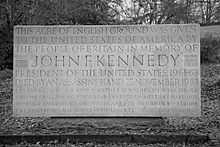Geoffrey Jellicoe
| Sir Geoffrey Jellicoe | |
|---|---|
| Born |
8 October 1900 Chelsea, London, England |
| Died | 17 July 1996 (aged 95) |
| Occupation | Architect |
| Projects | JFK Memorial Garden, Runnymede |
Sir Geoffrey Jellicoe (8 October 1900 – 17 July 1996) was an English architect, town planner, landscape architect, garden designer and author. His strongest interest was in landscape and garden design.[1]
Life
Jellicoe was born in Chelsea, London. He studied at the Architectural Association in London in 1919 and won a British Prix de Rome for Architecture in 1923, which enabled him to research his first book Italian Gardens of the Renaissance with John C. Shepherd. This pioneering study did much to re-awaken interest in this great period of landscape design and through its copious photographic illustrations publicized the then perilously decayed condition of many of the gardens.
In 1929 he was a founding member of the Landscape Institute and from 1939 to 1949 he was its President. In 1948, he became the founding President of the International Federation of Landscape Architects (IFLA). From 1954 to 1968 he was a member of Royal Fine Art Commission and from 1967 to 1974 a Trustee of Tate Gallery.
On 11 July 1936, he married Susan Pares (1907–1986), the daughter of Sir Bernard Pares KBE (1867–1949), the historian and academic known for his work on Russia.[2]
He died in 1996, the best-known English landscape architect of his generation.
Design projects

Note: All locations below are in England unless stated otherwise.
- 1934-36 Caveman Restaurant, Cheddar Gorge, Somerset.
- 1934-39 Ditchley Park, Oxfordshire
- 1935 Plan for Calverton Colliery, Calverton, Nottinghamshire
- 1936 The Great Mablethorpe Plan, Lincolnshire
- 1947 Plan for Hemel Hempstead, Hertfordshire
- 1956 Harvey's Store Roofgarden, Guildford, Surrey
- 1957-59 Water Gardens, Hemel Hempstead, Hertfordshire
- 1959 Cliveden Rose Garden, Taplow, Buckinghamshire
- 1964-65 Kennedy Memorial Garden, Runnymede, Surrey[3]
- 1970-90 Shute House
- 1979-89 Hartwell House Garden, Buckinghamshire
- 1980-86 Sutton Place Garden, Surrey
- 1984 Moody Gardens, Galveston, Texas, USA
Books and other publications
- Italian Gardens of the Renaissance (with J.C. Shepherd) (1926)
- Baroque Gardens of Austria (1932)
- The Shakespeare Memorial Theatre, Stratford-upon-Avon, etc. (1933)
- Garden Decoration & Ornament for Smaller Houses (1936)
- Gardens of Europe (1937)
- Report accompanying an Outline Plan for Guildford prepared for the Municipal Borough Council (1945)
- Studies in Landscape Design (1960)
- Motopia: A Study in the Evolution of Urban Landscape (1961)
- A Landscape Plan for Sark (1967)
- The Landscape of Man (1975)
- Blue Circle Cement Hope Works Derbyshire (1980?)
- The Guelph Lectures on Landscape Design (1983)
- The Oxford Companion to Gardens (1986)
- The Landscape of Civilisation (1989)
- The Studies of a Landscape Designer over 80 years (c.1993)
- Gardens & Design, Gardens of Europe (1995)
See also
- Landscape Institute
- Landscape planning
- Collective landscape
- International Federation of Landscape Architects
References
- ↑ "A Biography of Sir Geoffrey Jellicoe". Nightingale Garden Co. Ltd. 2008. Retrieved 20 March 2013.
- ↑ Moggridge, Hal (May 2005). "Geoffrey Jellicoe (1900–1996)". Oxford Dictionary of National Biography. Retrieved 27 January 2013.
- ↑ "Kennedy Family Coming For Memorial Inauguration". The Times (London) (56316): 6. 8 May 1965.
Mr Geoffrey Jellicoe, the architect for the site, said...that the point of the memorial was the landscape rather than any physical monument
Further reading
- Spens, Michael. The complete landscape designs and gardens of Geoffrey Jellicoe c1994
- Spens, Michael. Gardens of the mind c1992.
External links
- Portrait by Derry Moore, 1992 At the National portrait Gallery - Accessed April 2007
- Portrait by Anne-Katrin Purkiss, 1990 At the National portrait Gallery - Accessed April 2007
| ||||||||||||||||||||||||||||||||||||||||||||||||||||||||||||||||||||||||||||||||||||||||||||||||||||||||||||||||||||||||||||||||||||||||||||||||||||||||||||||||||||||||||||||||||||||||||||||||||||||||||||||||||||||||||||||||||||||||||||||||||||||||||||||||||||||||||||||||||||||||||||||||||||||||||||||||||||||||||||||||||||||||||||||||||||||||||||||||||||||||||||||||||||||||||||||||||||||||||||||||||||||||||||||||||||||||||||||||||||||||||||||||||||||||||||||||||||||||||||||||||||||||||||||||||||||||||||||||||||||||||||||||||||||||||||||||||||||||||||||||||||||||||||||||||||||||||||||||||||||||||||||||||||||||||||||||||||||||||||||||||||||||||||||||||||||||||||||||||||||
|